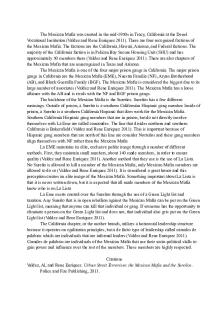Week 2 Summary-Pharmacokinetics PDF

| Title | Week 2 Summary-Pharmacokinetics |
|---|---|
| Course | Introductory Pharmacology |
| Institution | University of Newcastle (Australia) |
| Pages | 2 |
| File Size | 92.1 KB |
| File Type | |
| Total Downloads | 115 |
| Total Views | 159 |
Summary
Summary of Week 2...
Description
Define the term pharmacokinetics and identify which drug characteristics are pharmacokinetic characteristics. Process of drug and the fate of it in a living being, includes bioavailability, drug distribution, metabolism, drug interactions and excretion Describe, in general terms, the advantages and disadvantages of the major enteral and parenteral routes of administration & Be able to predict, in general terms, how the absorption of a drug is affected by the route of administration. absorption
pros
cons
oral
rectal
sublingal
Intravenous (IV)
subcutaneous
Intramuscular (IM)
Transdermal (patch)
inhaled
Understand the physicochemical characteristics of a drug that will affect the distribution of a drug. Describe the effect of plasma protein binding on drug distribution. If a lot binds to plasma proteins, most of the drug won’t go further than bloodstream If a drug has a high M.W it cannot cross cells/epithelial layers Molecular size, lipophilicity, pH trapping, protein binding (esp. plasma)
Describe the relationship between ionisation of a drug and its distribution, and between the pH of an environment and the degree of ionisation of a weak acid or alkali. The higher the ionisation, the less its distribution, Acidic drugs bind more readily in plasma bc the ph in plasma is higher than in tissue Describe (briefly) the two stages of metabolism and their purpose (detailed chemistry not required). Mainly in liver, 1: oxidation/reduction usu. Using cytochrome P450 enzyme, 2: conjugated (bit added to make it more water soluble/ polar) to be able to be convert lipid soluble to something water soluble so it can be excreted/urinated out Understand the types of drug interactions that can affect drug metabolism and drug action and the effects these will have on a person’s response to a drug. For enzymes: saturable, induced -
Can exceed enzyme availability, esp. multiple drugs @ the same time, competition = slower rate and can inhibit (e.g 2nd drug inhibits enzyme that is metabolising 1st drug) Metabolites of some drugs may also have a pharmacological activity, may be more active & toxic than parent & can get a build-up
List the factors which will affect rates of excretion of drug metabolites and how this may affect response to a drug. Once metabolites are h20 soluble-> filtered by kidney -> urine Most drugs will be filtered by the kidney, unless protein bound Lipid soluble drugs are absorbed rapidly Weak acids excreted more rapidly in alkaline urine & weak bases are excreted more rapidly in acidic urine Be able to define the following and apply knowledge of these measures to clinical scenarios in which they may impact a person’s response to a drug. Volume of distribution: volume of drug dose based on plasma concentration (L) Clearance: plasma cleared of drug per unit time e.g mL/min half-life: time for half of the drug to disappear/breakdown therapeutic range: drug conc. With therapeutic effect with min. adverse effect Apply your knowledge of the above in the context of the therapeutic use of drugs....
Similar Free PDFs

Week 2 - week 2
- 4 Pages

Week 2 - week 2
- 12 Pages

Week 2- Disscision - Week 2
- 1 Pages

Week 2 quiz 511 - Week 2 Quiz
- 8 Pages

PSQF Week 2 Notes 2, Week 3
- 13 Pages

Week 2
- 4 Pages

Week 2 Post - Week 2 Post
- 1 Pages

Week-2 Leccture - lecture week 2
- 2 Pages

2 - nursing tutorial week 2
- 3 Pages

Week 2 DQ 2 - graded
- 1 Pages

WEEK 2 - Lecture notes 2
- 5 Pages

Week 2 - Lecture notes 2
- 7 Pages

Week 2 - ppppppppppppppppppppppppp
- 30 Pages
Popular Institutions
- Tinajero National High School - Annex
- Politeknik Caltex Riau
- Yokohama City University
- SGT University
- University of Al-Qadisiyah
- Divine Word College of Vigan
- Techniek College Rotterdam
- Universidade de Santiago
- Universiti Teknologi MARA Cawangan Johor Kampus Pasir Gudang
- Poltekkes Kemenkes Yogyakarta
- Baguio City National High School
- Colegio san marcos
- preparatoria uno
- Centro de Bachillerato Tecnológico Industrial y de Servicios No. 107
- Dalian Maritime University
- Quang Trung Secondary School
- Colegio Tecnológico en Informática
- Corporación Regional de Educación Superior
- Grupo CEDVA
- Dar Al Uloom University
- Centro de Estudios Preuniversitarios de la Universidad Nacional de Ingeniería
- 上智大学
- Aakash International School, Nuna Majara
- San Felipe Neri Catholic School
- Kang Chiao International School - New Taipei City
- Misamis Occidental National High School
- Institución Educativa Escuela Normal Juan Ladrilleros
- Kolehiyo ng Pantukan
- Batanes State College
- Instituto Continental
- Sekolah Menengah Kejuruan Kesehatan Kaltara (Tarakan)
- Colegio de La Inmaculada Concepcion - Cebu


